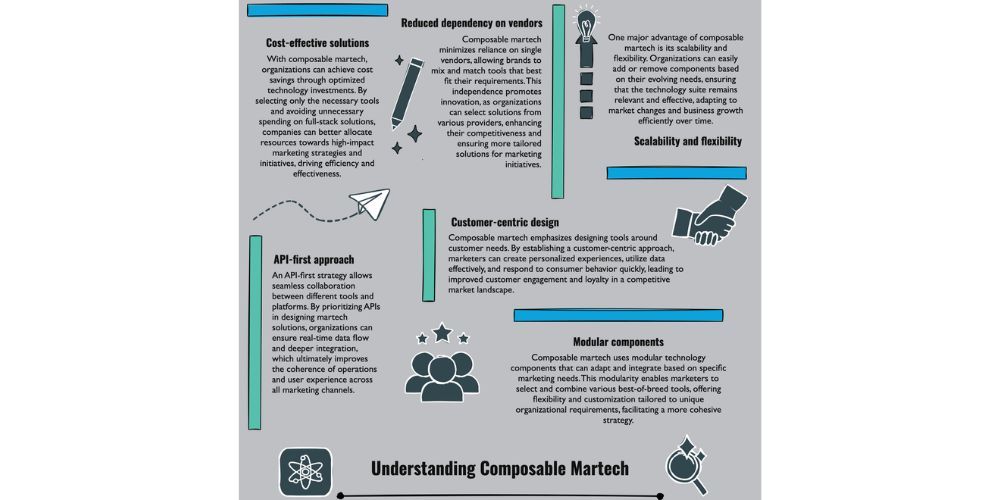The Rise of Composable MarTech: What It Means for Marketing Leaders
According to Gartner, by 2027, organizations that have adopted a composable approach will outpace competition by 80% in the speed of new feature implementation. Yet as of early 2025, a staggering 72% of enterprise MarTech implementations still fail to deliver their promised ROI—largely due to the rigidity of traditional monolithic architectures.
We're witnessing the end of the all-in-one MarTech suite era. These monolithic platforms—once considered the gold standard for enterprise marketing—have become anchors rather than engines, unable to adapt to the 18-month innovation cycles that now define competitive advantage in digital marketing.
Enter composable MarTech: a fundamentally different approach rooted in MACH principles (Microservices, API-first, Cloud-native, Headless). Rather than betting your entire marketing operation on a single vendor's roadmap, composable architecture allows you to assemble best-of-breed solutions that can be continuously optimized, replaced, or enhanced without disrupting your entire ecosystem.
For CMOs and marketing leaders facing unprecedented pressure to drive growth while optimizing investments, this isn't just another IT trend—it's a strategic imperative that directly impacts revenue generation, customer experience, and competitive positioning. In today's environment, flexibility and adaptability aren't luxuries; they're table stakes for survival.

What Is Composable MarTech?
At its core, composable MarTech is an architectural approach that emphasizes building marketing technology ecosystems from interchangeable components rather than all-in-one solutions. Think of it as switching from buying a pre-built house to creating a custom home with modular, high-quality components that can be reconfigured as your needs change.
Unlike suite-based platforms that lock you into a single vendor's roadmap, composable MarTech embraces three fundamental principles:
- Modularity: Individual capabilities are packaged as discrete, specialized components that excel at specific functions rather than attempting to do everything adequately
- Interoperability: All components communicate seamlessly through standardized APIs, creating a cohesive ecosystem despite having different origins
- Orchestration: Business logic and workflows connect these modular components, allowing them to work together while remaining independently manageable
| Traditional Suite-Based MarTech | Composable MarTech |
|---|---|
| Single vendor dependency | Multi-vendor ecosystem |
| Monolithic upgrades | Component-level improvements |
| Rigid functionality | Flexible capabilities |
| Incremental innovation | Continuous transformation |
| IT-dependent | Business-empowered |
| Feature compromises | Best-of-breed for every function |
For marketing leaders, composable MarTech offers a compelling vision: the ability to deliver exceptional customer experiences through technology that adapts as quickly as market conditions change.
Why Now? The Market Drivers of Composability
Several converging forces are making composable MarTech not just viable but necessary for forward-thinking organizations.
Accelerating Pace of Digital Innovation
The half-life of marketing technology is shrinking dramatically. What represented cutting-edge capabilities three years ago is table stakes today. Composable architectures allow you to incorporate emerging technologies without disrupting your entire marketing operation.
The Omnichannel Imperative
Customers now demand seamless experiences across an ever-expanding array of touchpoints. Legacy platforms designed for a simpler digital landscape simply cannot adapt quickly enough to these expectations. Composable systems enable real orchestration rather than just basic integration across channels.
Marketing-IT Convergence
The traditional boundaries between marketing and IT continue to blur. Modern CMOs need technical fluency just as much as CIOs need business acumen. Composable MarTech creates a shared language and set of priorities that bridges these functions.
Economic Uncertainty
Budget constraints are forcing smarter, more strategic technology investments. Composable approaches allow for incremental adoption and value realization rather than massive, risky replatforming projects.
Key Takeaways
- Composable MarTech enables organizations to respond faster to market changes and customer expectations
- The approach aligns with broader business trends toward agility and resilience
- It represents a strategic advantage rather than just a technical implementation choice
The Strategic Benefits for Marketing Leaders
For CMOs and senior marketing leaders, composable MarTech delivers advantages that directly impact business performance.
Strategic Agility
The average enterprise takes 6-12 months to implement significant changes to their marketing technology. Composable architectures can reduce this to weeks or even days, dramatically accelerating time-to-market for new campaigns, experiences, and business initiatives.
Risk Mitigation
Composability reduces vendor lock-in and creates graceful paths to adopt new technologies. When a component underperforms, it can be replaced without disrupting your entire marketing ecosystem—protecting your overall technology investment.
Enhanced Customer Experiences
By combining best-of-breed solutions for each customer touchpoint, marketing teams can deliver more personalized, contextual experiences that drive engagement and conversion. The ability to rapidly experiment and refine these experiences creates sustainable competitive advantage.
Operational Efficiency
With properly implemented composable systems, marketing teams spend less time wrangling technology and more time focusing on strategy and creative execution. This drives both team productivity and marketing ROI.
Data Activation
Perhaps most importantly, composable architectures enable marketing teams to unify customer data across touchpoints and activate it in real-time. This creates the foundation for the personalization and customer intelligence that define marketing excellence.
Key Challenges and Considerations
While the benefits are compelling, transitioning to a composable approach presents several challenges that marketing leaders must address.
Integration Complexity
Even with robust APIs, creating a cohesive ecosystem requires thoughtful architecture and ongoing governance. Without proper planning, you risk creating a fragmented experience that's harder to manage than the monolith it replaced.
Organizational Readiness
Composable MarTech often requires new skills, processes, and organizational structures. Marketing teams accustomed to suite-based tools may struggle with the shift toward greater technical involvement and cross-functional collaboration.
Vendor Evaluation Criteria
Selecting partners for a composable stack requires different evaluation criteria than traditional procurement processes. Marketing leaders need to assess API capabilities, developer experience, and ecosystem compatibility alongside traditional feature comparisons.
Governance and Oversight
With components from multiple vendors, establishing clear accountability and performance management becomes more complex. Strong governance frameworks are essential to prevent technical sprawl and security vulnerabilities.
Key Takeaways
- Composable MarTech requires thoughtful implementation and strong architecture
- Success depends as much on people and process as on technology
- The transition is a journey rather than a single implementation project

Download a PDF copy of the Composable MarTech Explained infographic.
Getting Started with Composable MarTech
For marketing leaders considering this approach, here's a pragmatic roadmap to begin your composable journey.
1. Audit Your Current Stack
Before making any changes, thoroughly map your existing technology landscape, identifying:
- Current capabilities and gaps
- Integration pain points
- Areas where lack of flexibility impacts business outcomes
- Technologies approaching end-of-life or renewal
Download the MarTech Audit Checklist to get started.
2. Align Technology Decisions with Business Priorities
Identify the specific business outcomes that would benefit most from increased agility and flexibility. Common starting points include:
- Content delivery across multiple channels
- Customer data unification and activation
- Experimentation and personalization capabilities
- Campaign management and orchestration
3. Establish Architectural Principles
Work with IT partners to define guardrails for your composable ecosystem:
- API standards and data governance requirements
- Security and compliance minimums
- Integration patterns and middleware strategies
- Documentation and knowledge management expectations
4. Start with High-Impact, Low-Risk Components
Rather than a wholesale transformation, identify specific components where composable approaches offer immediate value:
- Headless CMS implementations for multi-channel content delivery
- Customer Data Platforms (CDPs) for unified profile management
- API-driven personalization engines
- Cloud-based digital asset management
5. Build Internal Capabilities Incrementally
Develop your team's capabilities alongside your technology:
- Create centers of excellence around key components
- Establish cross-functional workstreams bringing together marketing, IT, and business stakeholders
- Invest in training and change management
- Consider partnerships to accelerate capability development
Checklist: 5 Steps to Start Transitioning to Composable MarTech
- Complete a comprehensive MarTech audit and gap analysis
- Identify 2-3 high-impact use cases that could benefit from composable approaches
- Establish architectural principles in partnership with IT
- Select initial components for implementation and proof of concept
- Develop a capability roadmap addressing both technology and talent needs
Future Outlook: Composability as Competitive Differentiator
As we look ahead, several trends will accelerate the importance of composable approaches.
The Rise of MarTech Ecosystems
Major platforms are increasingly positioning themselves as ecosystems rather than all-in-one solutions. These ecosystems provide the infrastructure and marketplace for composable components, simplifying discovery and integration.
AI Integration as Standard
Artificial intelligence is rapidly becoming embedded in every aspect of marketing technology. Composable architectures make it easier to incorporate specialized AI capabilities exactly where they deliver the most value, rather than being limited to what your platform vendor provides.
No-Code/Low-Code Democratization
The technical barriers to composability are rapidly falling. No-code integration platforms and visualization tools are making it easier for marketing teams to orchestrate complex, multi-vendor workflows without deep technical expertise.
Experience Orchestration at Scale
The ultimate promise of composable MarTech is the ability to orchestrate personalized customer journeys at massive scale across all touchpoints. Organizations that master this capability will create sustainable competitive advantage that's difficult to replicate.
The Composable Advantage in a Rapidly Changing Market
The transition to composable MarTech represents far more than a technical architecture decision—it's a strategic repositioning that fundamentally transforms how marketing organizations operate in today's hyper-competitive landscape. As we've seen from industry leaders like Sephora, IKEA, and Ulta Beauty, the benefits are tangible, measurable, and increasingly essential for maintaining competitive advantage.
This increased agility is the true promise of composable MarTech:
- Responding to market disruptions in real-time, not quarters
- Experimenting with emerging technologies without massive replatforming
- Delivering truly personalized experiences that evolve with customer expectations
- Extracting measurable business value from every technology investment
What's become increasingly clear is that the organizations dominating their categories in 2025 and beyond won't be those with the largest marketing budgets or the most extensive feature lists. The market leaders will be those who build the organizational capability to continuously adapt, experiment, and evolve their customer experiences while their competitors remain constrained by rigid technology ecosystems.
By embracing composable principles today, you're not simply making a technology architecture decision—you're fundamentally repositioning your marketing organization for resilience and growth in an era where the only constant is change. The question is no longer whether to move toward composability, but how quickly you can begin the journey.
As LVMH's Chief Digital Officer put it after implementing their composable platform across 75+ luxury brands: "The ability to share technological capabilities while preserving brand uniqueness isn't just an efficiency play—it's become our core competitive advantage in a digital-first luxury market."
For marketing leaders standing at this crossroads, the message is clear: composable MarTech isn't just another trend in a constantly changing landscape—it's the architectural foundation upon which the future of marketing will be built.
What's the difference between "composable MarTech" and the "best-of-breed" approach we've used for years?
While there are similarities, composable MarTech represents a more evolved approach than traditional best-of-breed. Traditional best-of-breed focused primarily on selecting the strongest tools in each category, but often resulted in disconnected silos that required complex, custom integrations.
Composable MarTech takes this concept further by:
- Emphasizing standardized APIs and integration patterns from the outset
- Requiring true modularity rather than just feature superiority
- Focusing on the organization's capability to continuously compose, decompose, and recompose the stack as needs change
- Leveraging MACH (Microservices, API-first, Cloud-native, Headless) principles at the architectural level
- Incorporating orchestration layers that allow components to work seamlessly together
In essence, composable MarTech brings architectural discipline to the best-of-breed approach, making it more sustainable and adaptable over time.
How can I justify the investment in transitioning to composable MarTech when our current platform still "works"?
This is ultimately about opportunity cost and future-proofing your organization. While your current monolithic solution may "work" today, consider these factors in your business case:
Quantifiable costs of staying with the status quo
- Lost revenue from delayed market responses (calculate the cost of your current time-to-market for new capabilities)
- Integration and customization costs that continue to rise as you stretch your current platform
- The "technical debt tax" you're paying for maintaining workarounds and patches
- Vendor lock-in costs, including unfavorable renewal terms and forced upgrades
Quantifiable benefits of composability
- Acceleration of time-to-market (as seen in Sephora's 4x improvement)
- Reduced total cost of ownership through right-sized components
- Improved campaign performance (Ulta Beauty's 40% lift)
- Enhanced ability to scale during market disruptions (IKEA's 300% digital sales growth)
- Lower switching costs for underperforming components
Most importantly, frame this as a staged transformation rather than a "big bang" replacement, allowing you to show incremental ROI while building toward the larger vision.
What organizational changes do we need to make to succeed with composable MarTech?
Successful composable implementations require evolution in your team structure, skills, and processes.
Team Structure
- Create cross-functional pods that own specific customer journeys or capabilities
- Establish a MarTech governance committee with representatives from marketing, IT, data, and compliance
- Consider a dedicated integration or "marketing engineering" team that bridges marketing and IT
Skills Development
- Enhance marketing teams' technical literacy, particularly in API concepts and data modeling
- Develop or acquire expertise in integration platforms and middleware
- Build product management capabilities to treat MarTech components as products with roadmaps
Process Changes
- Implement agile methodologies for continuous testing and improvement
- Create standardized evaluation frameworks for new technologies
- Develop clear documentation practices for integrations and workflows
- Establish metrics to measure both technical performance and business outcomes
Organizations that invest in these organizational changes alongside their technology transformation see significantly higher returns from their composable MarTech investments. Consider partnering with external experts initially to accelerate capability development while building internal expertise.
Author: William Flaiz










